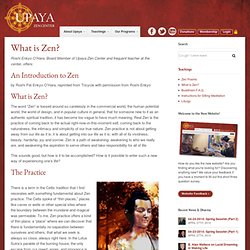

How to Meditate Daily. Post written by Leo Babauta.
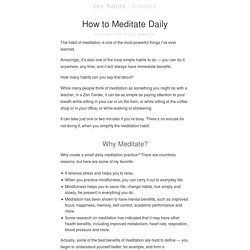
The habit of meditation is one of the most powerful things I’ve ever learned. Amazingly, it’s also one of the most simple habits to do — you can do it anywhere, any time, and it will always have immediate benefits. How many habits can you say that about? While many people think of meditation as something you might do with a teacher, in a Zen Center, it can be as simple as paying attention to your breath while sitting in your car or on the train, or while sitting at the coffee shop or in your office, or while walking or showering. It can take just one or two minutes if you’re busy. Why Meditate? Why create a small daily meditation practice? Actually, some of the best benefits of meditation are hard to define — you begin to understand yourself better, for example, and form a self-awareness level you’ve never had before. Audio: Meditation. Guided Meditations with Malcolm Huxter Body Scan gives instructions on bringing awareness to bodily sensations.
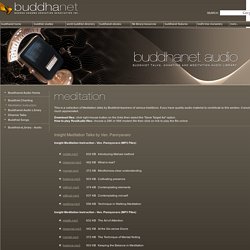
For the most part this exercise is relaxing. Occasionally practitioners initially feel uncomfortable with this exercise. If it becomes overwhelmingly distressing, merely distract or direct attention to something outside your body until you are more comfortable with the exercise at another time. Progressive Relaxation gives guidance for a common muscle tension and release exercise often used for stress management. Calming the body with the breath, describes a mindfulness of breath exercise coupled with relaxation. Cultivating peace and joy with the breath, is an extension of the track "Calming the body with the breath". Mindful Standing and Walking, provides simple instructions for mindful standing and walking.
Mindfulness of Breath gives instructions for mindfulness of breath, as is it experienced as movement in the abdomen. Meditation Station - 108 Meditation Techniques. Guided Meditations. UCLA Mindful Awareness Research Center. Buddhist Symbols and Mudras (Gestures of the Buddha) MRI Technician Schools: 350+ Online MRI Tech Programs. Whether you are a Zen Buddhist or just want to lead a Zen life, these 50 spiritual and simplifying blogs and community web sites will point you down the path of enlightenment.

Explore the first sub-section to learn how to have a happy, fulfilled life through Zen-inspired lessons and mantras. The second sub-section is dedicated to those who are seeking a more spiritual side of Zen like Zen Buddhism. Many of these blogs feature meditations and insight on the path to Enlightenment. Learn to Live Peacefully Blogs 1. zenhabits – This no-frills site focuses on ways of slowing down and enjoying life to its fullest. 2. Ahh. 13 Steps to Higher Energy - BasicMeditationTechniques.pdf. Buddhism and the God-idea. Do Buddhists believe in a god?

No, we do not. There are several reasons for this. The Buddha, like modern sociologists and psychologists, believed that religious ideas and especially the god idea have their origins in fear. The Buddha says: Gripped by fear people go to sacred mountains, sacred groves, sacred trees and shrines. Primitive humans found selves in a dangerous and hostile world, the fear of wild animals, of not being able to find enough food, of injury or disease, and of natural phenomena like thunder, lightning and volcanoes were constantly with them. The second reason the Buddha did not believe in a god is because there does not seem to be any evidence to support this idea.
The third reason the Buddha did not believe in a god is that the belief is not necessary. But if there are no gods how did the universe get here? All religions have myths and stories which attempt to answer this question. Audio Dharma - Welcome to Audio Dharma. Buddha+Message.jpg (JPEG-Grafik, 1194 × 728 Pixel) - Skaliert (82%) BEGINNER'S GUIDE ... © 1995 Dharman Craig PressonAll Rights Reserved “Zen is not what you think!”
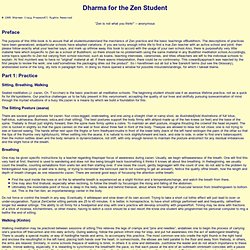
-- anonymous Preface The purpose of this little book is to assure that all studentsunderstand the mechanics of Zen practice and the basic teachings ofBuddhism. The descriptions of practices have been generalized, andparticular schools have adopted variations. Part 1: Practice Sitting, Breathing, Walking Seated meditation (J. zazen, Ch. The Sitting Posture (asana) How to Meditate - Guided Meditation Techniques - Buddhist Meditations. Advanced Meditation Guide. Basic instructions Sit in a comfortable position with your back straight, the crown of your head ‘pulled upwards’ and your chin turned in a little towards your chest.
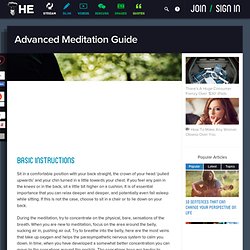
If you feel any pain in the knees or in the back, sit a little bit higher on a cushion. Spirit Vaults : Meditation - Essay. It seems everyone is interested in meditation...talking about the wonderful benefits, recommending classes and discussing the different ways to "do it".
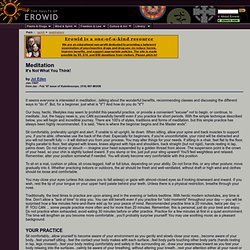
But, for a beginner, just what is "it"? And how do you do "it"? Our busy, hectic, lifestyles may seem to prohibit this peaceful practice, or provide a convenient "excuse" not to begin, or continue, to meditate...but, the happy news is, you CAN successfully benefit even if you practice for short periods. With the simple technique described below, you will begin and incredible journey. Zen Koans - AshidaKim.com. » 12 Essential Rules to Live More Like a Zen Monk.
Life After Death: Buddhism - Life After Death, Christianity, Islam, Buddhism, Philosophy, Science : Life After Death, Christianity, Islam, Buddhism, Philosophy, Science. Buddhism originated from Hinduism, but diverges significantly in its representation of the karmic cycle of life, death and rebirth. For Buddhists, the ultimate goal of humanity is to reach nirvana – a state of blissful non-existence. Humans are trapped in a cycle of being reincarnated over and over again because we each have a set of desires and ideas that clings onto us, even after we die. The concept of nirvana illustrates the Buddhist belief that there is no eternal soul.
Lojong. Lojong (Tib.

བློ་སྦྱོང་,Wylie: blo sbyong) is a mind training practice in the Tibetan Buddhist tradition based on a set of aphorisms formulated in Tibet in the 12th century by Geshe Chekhawa. The practice involves refining and purifying one's motivations and attitudes. The fifty-nine or so slogans that form the root text of the mind training practice are designed as a set of antidotes to undesired mental habits that cause suffering. Awakening the Mind: A Journey for Contemporary Life. Zen Buddhism. Zen Center: An Introduction to Zen. Roshi Enkyo O’Hara, Board Member of Upaya Zen Center and frequent teacher at the center, offers:
